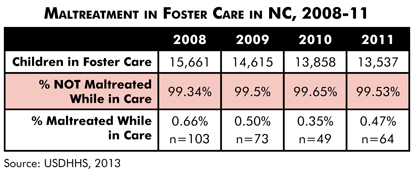 |
 |
 |
Vol.
18, No. 2
May 2013
Preventing Maltreatment in Foster Care
When the state takes one of the most intrusive steps it can take and removes children from their parents, at the very least we must keep the children safe. That's why we set the bar so high for foster parents and kin caregivers. As a foster care alum put it, "Foster parents need to be a cut above."
Most are. Yet despite our best efforts, maltreatment in foster care does occur. Though it is rare, we all find this kind of maltreatment particularly offensive and outrageous, since safety is the reason kids are in foster care in the first place.
North Carolina's Performance
Reducing the incidence of child abuse and neglect in foster care is a high priority for North Carolina. While data indicates that the vast majority of children in foster care are safe in their placements, we can do better.

As this table illustrates, North Carolina showed a significant improvement in the rate of maltreatment in foster care between 2008 and 2010. Viewed from a national perspective, our performance in this area was about average (USDHHS, 2011). However, we did see a concerning uptick in 2011. Though the rise was slight, any movement in the wrong direction is cause for concern.
So what can we do to re-focus our efforts to reduce--and prevent--maltreatment of children in foster care?
Screening Before Licensing
Prevention guidelines issued by the Child Welfare League of America (2003) lists "careful selection, preparation and training of foster parents" as a top priority. It is critical to realistically and candidly explore with all prospective foster parents the challenges of fostering, their motivations for fostering, their personal and family histories, and their capacity to meet the needs of children in foster care.
In North Carolina we use a mutual selection process where both the child-placing agency and the prospective family seek to learn enough to make a sound judgment about the family's suitability for licensing.
Assessing applicants isn't always easy. For some social workers, it can be difficult to assess whether an identified need is something to work on over time with a family, or whether it's a reason not to license them. For others, it is hard to know the words to use to turn down an applicant, especially in an era when people are quick to litigate or broadcast hard feelings over social media.
To address these challenges, child-placing agencies are encouraged to have more than one staff person meet with each applicant, and to conduct team staffings of all licensing applications. Both practices help ensure a fair, well-rounded assessment and a thoughtful screening decision in keeping with the agency's values and resources. The team approach also promotes early and consistent discussion of what the agency needs to do to support, train, and develop each foster family, laying the groundwork for comprehensive professional development plans.
Reducing Risk Factors
The NC Division of Social Services has stepped up efforts to ensure agencies adequately screen potential resource families. In communications with all county DSS and private child-placing agencies, Division staff have shared recent data on maltreatment in foster care and revocations of foster home licenses to emphasize the importance of careful selection of resource parents.
According to the Division, most recent revocations of foster parent licenses have been related to substantiations for neglect--specifically, for the use of corporal punishment (FCRP, 2011). Factors precipitating the use of corporal punishment in these instances included "stress due to loss of employment" and family history--the foster parents grew up in households where corporal punishment was the primary means of punishment (FCRP, 2011).
Based on their review of the literature, Holder and colleagues (2003) suggest that the "nature and characteristics of a maltreating kinship or foster parent may not be pre-existing traits but may evolve or be stimulated into action as a result of the substitute care provider's experience." It may be that a variety of factors are at play, such as inadequate preparation for the extent and types of child behaviors. A shortage of foster parents may also lead agencies to ask families to care for more children than they can handle (Grayson, 1988).
Workers and supervisors need to know on a continuous basis how families are faring. Ample support is essential.
Strengthening Protective Factors
We can prevent maltreatment in foster care not only by reducing risk factors, but by strengthening protective factors that keep children safe. As the table on the next page illustrates, the Strengthening Families framework (CSSP, n.d.) is a lens that can help understand and support resource families. Whenever we can help a family in any of these areas, we increase the overall well-being of the family and the chances the child will have a better placement experience.
Summary
Providing foster care can be tough. It's not for everyone, and it takes both the agency and the family working in partnership to make the placement successful. Those who welcome the opportunity need support. It's up to social workers to open the door for families to celebrate the strengths of the placement, to share their concerns, and to know they are not alone in the hardships they face.
